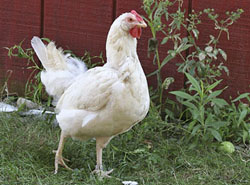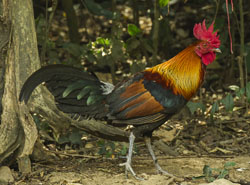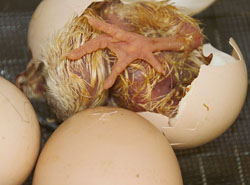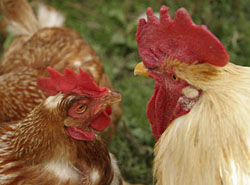- Bees
- Chickens
- Cows
- Deer
- Donkeys
- Elephants
- Frogs
- Geese
- Horses
- Lobsters
- Pigs
- Rabbits
- Rats
- Seals
- Sheep
- Turkeys
Chickens

A mature male chicken is called a rooster or cock or roo. A mature female chicken is called a hen. A chick is a newly hatched chicken. An immature male chicken is called a cockerel and an immature female chicken a pullet.
A chicken is a bird. There are over 150 varieties of domestic chickens. They were domesticated about 8000 years ago.
A chickens' heart beats 280-315 times a minute. A chickens' body temperature runs at 102-103 degrees F. A rooster takes 18-20 breaths a minute, a hen 30-35.
Chickens are not capable of sustained flight. The longest recorded flight of a chicken is thirteen seconds. A chicken can travel up to 9 miles per hour.

All domestic chickens can be genetically traced to Gallus Gallus, the red jungle fowl. The chicken is the closest living relative of the t-rex.
Chickens come in an infinite variety of colors and patterns. There are seven distinctive types of combs on them: rose, strawberry, single, cushion, buttercup, pea and V-shaped.
Chickens make sounds with actual meaning. They give different alarm calls when threatened by different predators. A rooster will attack anything that he thinks will harm the hens. Their spurs (located at the back of their leg) can cause a very painful puncture wound.

A hen can live up to 20 years. She will lay eggs her entire life, with the number decreasing every year from year one.
Chickens lay different colored eggs, from white, to brown, to green, to pink, to blue. The color of a hen's first egg is the color she will lay for life. It takes a hen 24-26 hours to lay an egg.
A chicken finds it very important to have a private nest. She builds her nest by first scratching a hole in the ground. She will then pick up twigs and leaves, which she will drop on her back. Back in the hole she will let the material slide off her back around the rim.
It takes a chick 21 days to develop in the egg. It starts developing when it reaches a temperature of 88 degrees F. A mother hen begins bonding with her chicks before they are even born. She will turn her egg as often as five times an hour and cluck to her unborn chicks, who will chirp back to her and to one another.

If a rooster is not present in a flock of hens, a hen will often take the role, stop laying, and begin to crow.
A chicken can have 4 or 5 toes on each foot.
Chickens have more bones in their necks than giraffes. They have no teeth and swallow their food whole. Part of their stomach is used to grind their food up.
Chickens are very social animals. They will fight to protect their family and will mourn when a loved one is lost.
There are more chickens than people in the world.



